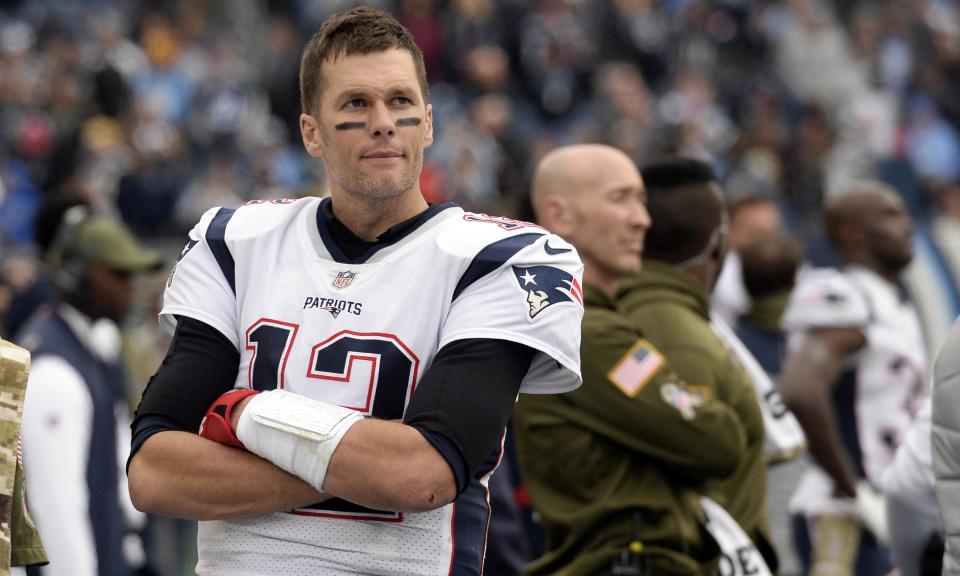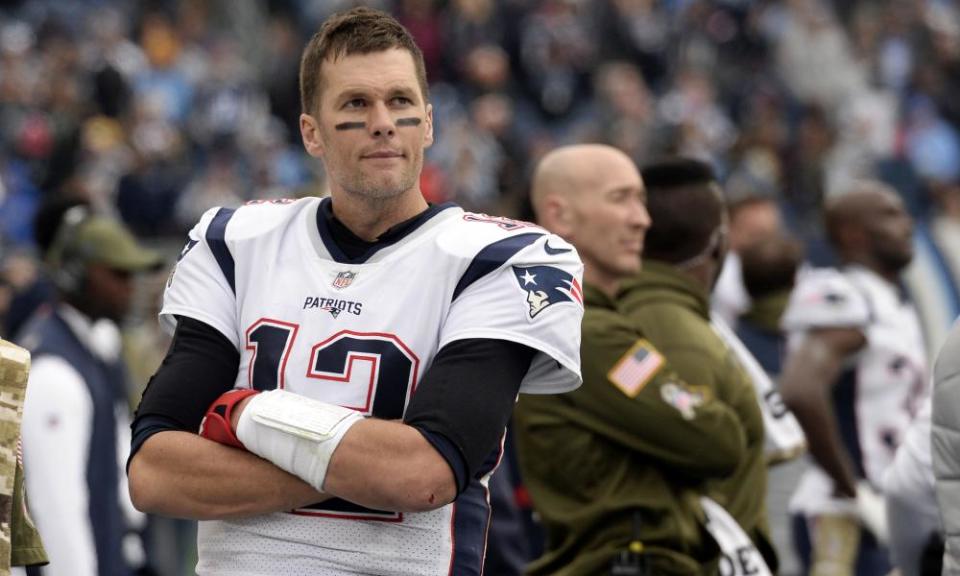'I want to play better': is 2018 the start of Tom Brady's NFL decline?
It’s time for that biennial tradition of looking at a couple of bad Tom Brady performances and wondering if this is the beginning of the end for the man, the Patriots dynasty and possibly civilization itself.
Hyperbole typically surrounds bad Brady outings: after all, they’re so infrequent, we have to get our kicks in. There is something noticeably different this time, though. It’s not just his age (41), it’s the manner of the performances. It’s not as visceral as the night in Kansas City back in 2014 when Brady was picked off twice and replaced by Jimmy Garoppolo in a 41-14 loss, but something feels off.
Is this the end? No. But there are undoubtedly warning signs – and Brady sees it himself. “I absolutely want to play better,” he said in an interview with Jim Gray of Westwood One this week. “I want to play as best as I possibly can for my team, and that’s what my job is to do.”
Brady has strung together a quintet of seasons the likes of which we’ve never seen from someone his age. He ran off the upstart, Garoppolo. He claimed an extra pair of Super Bowl titles. He played in another, putting up the best single statistical game of his career. He single-handedly redefined the NFL’s aging curve, if anything he seemed to be getting younger. Rarely do people string together five such years at their athletic apex, let alone entering their 40s. Could it be as simple as avoiding strawberries? We all wondered.
READ MORE: Why Alex McCarthy's parents missed his Three Lions debut
READ MORE: Neymar not a target for Barcelona but door kept open for return
READ MORE: Manchester United vice-chairman Woodward reveals Dinnage expectations
2018 has been different. It’s not that Brady is playing poorly, it’s that he’s playing a tick below his typically brilliant standards. He’s eighth in total quarterback value (DYAR) and 12th in down-to-down efficiency (DVOA), figures that put him ahead of Aaron Rodgers, Cam Newton, and Andrew Luck. They’re numbers that would be perfectly good for any normal player, but Brady is not just anyone; he wants to play until he’s 45. He hasn’t ruled out playing until 50.
Most jarring of all are Brady’s numbers against the blitz. When teams send an extra defender or two, Brady’s passer rating tanks to 59.6, the very worst mark in the league. Good NFL quarterbacks traditionally shred the blitz. When the opposition send an extra defender, that leaves a receiver open — or means it’s single coverage across the board.
Defenses rarely blitz the best of the best. In fact, Brady has been blitzed less than any other quarterback in the game this season (15% of his snaps). He has made a reputation out of deciphering opposition schemes and making defensive coordinators look foolish, before forcing a defense to play safe (before happily picking them apart).
This season, though, he’s beating defenses as often as any other average NFL quarterback, not the greatest timing-based thrower to ever play the game. What gives? Part of the problem has been his receivers, rather than Brady himself.
Rob Gronkowski has been creaking all season, and he’s unlikely to play in full health for the rest of his career. Josh Gordon has been good, not great: some highlight plays have masked general inconsistencies, while Julian Edelman has yet to return to the form he showed before injuries and his PED suspension interrupted his career. In fact, Brady’s most reliable pass-catchers have been running backs leaking out of the backfield. They’re a great weapon to sprinkle into a system here and there, but not as a primary point of attack.
But despite the deficiencies in his receiving corps, Brady’s struggles with the blitz are a genuine worry. It’s one of the first signs a quarterback’s age is starting to catch up with him. We think of the deep ball as being the most obvious evidence a quarterback is declining but arm strength rarely evaporates overnight. And while Brady’s deep ball numbers have tumbled (he’s 24th in the NFL in deep passing accuracy), his arm is not noticeably weaker.
The greats typically learn a new way to play the game once their arm goes, one based on anticipation rather than athletic gifts, yet that’s always been Brady’s game.
Picking up blitzes is all about a quarterback’s eyes, decision-making, and having just enough fluidity in the hips to reset the feet and get the ball out on time. All of that gets a tick slower as a player gets older. The defenders move a beat faster. The feet don’t move quite as swift as you’d like. The result is a snap-to-delivery time that’s a fraction too slow. We’re used to Brady elevating the play of all those around him. He can still get there, but it’s no longer a guarantee.
All-time greats usually take one of three diverging paths. Their body gives out, they fall off a performance cliff, or they slowly decline, relying on the organization around them to adjust. John Elway is perhaps the best example of the latter scenario. He carried the Broncos until his body could shoulder the load no more. Denver adapted, installing an innovative offense that put less onus on the quarterback and more on everyone else, and Elway led them to two Super Bowls in his late 30s.
Brady hasn’t slipped as much as late-stage Elway, and the Patriots don’t have the talent this year to make any wholesale adjustments – they lack the offensive line and defense. But it’s time for Bill Belichick and company to start plotting the future. New England can still win – big – with Brady playing at his current level, but they must adjust around his declining play.
Folks in New York, Miami and Buffalo shouldn’t get too excited just yet. Brady is still playing at a top-10 level, he’s just no slam dunk to finish the season as one of the league’s top-five passers. More than ever, though, there’s a sense that we’re drawing closer to the end.

 Yahoo Sport
Yahoo Sport 





































































